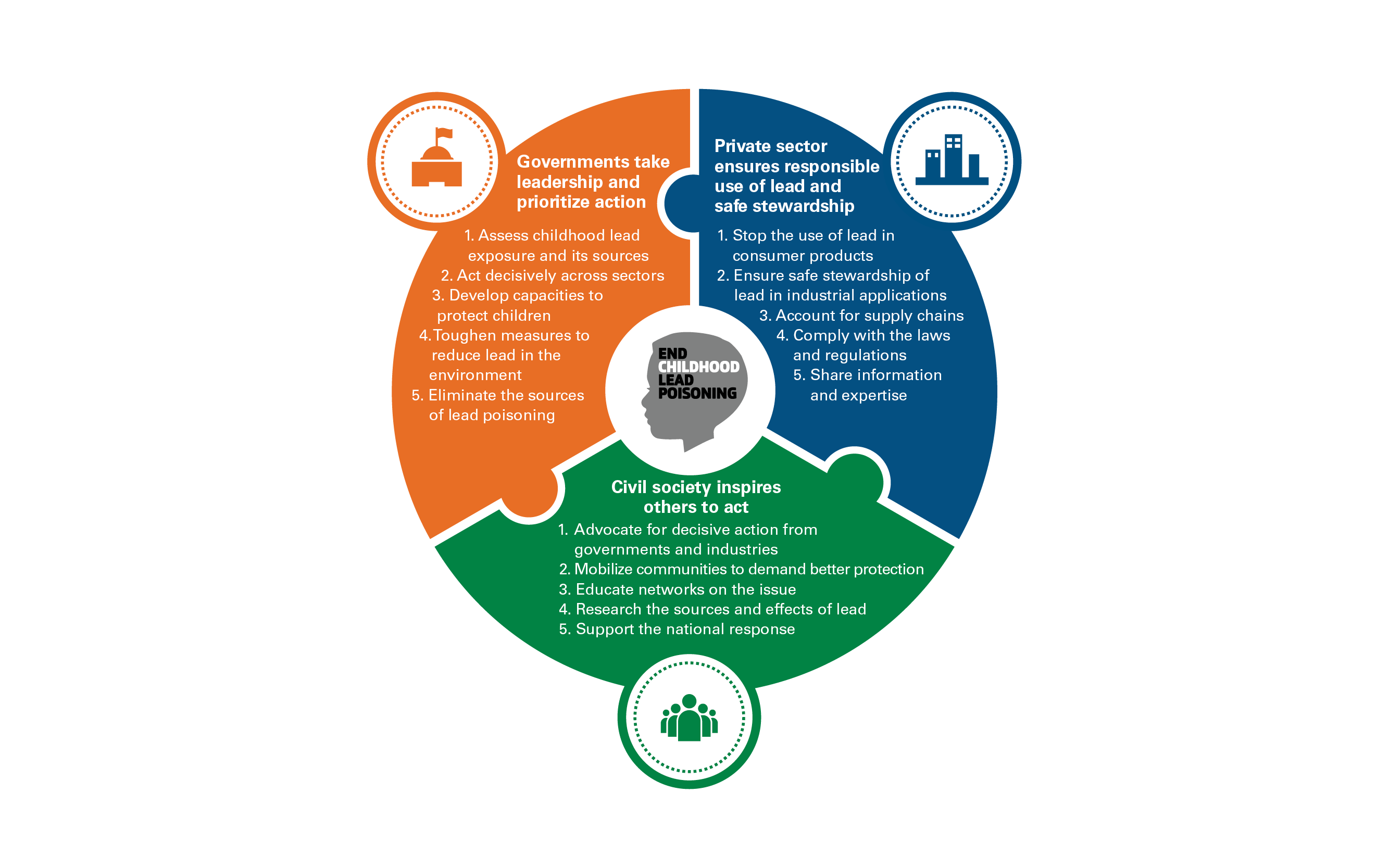Lead poisoning
The problem
Lead is a highly poisonous heavy metal. Exposure to even small amounts of lead over time can have lifelong effects on children, inflicting irreversible damage to their developing bodies and brains. Significant levels of lead poisoning in many low- and middle-income countries result from the irregular use of lead in consumer products such as spices, paints and dyes, cookware and ceramics, cosmetics, toys and others.
Lead is vastly used for lead-acid batteries in vehicles and other industrial applications. The unsafe recycling of batteries and e-waste contaminates the air, water and soil in surrounding communities. There is no cure for lead poisoning – the damage it causes cannot be reversed.
Prevention is the only solution.
The World Bank’s 2023 assessment reveals that the global cost of lead exposure was US$6.0 trillion in 2019, ranking lead exposure as an environmental risk factor on par with PM2.5 ambient and household air pollution combined, and ahead of unsafe household drinking water, sanitation and handwashing.
815
million
children globally – around one in three – have blood lead levels at or above 5 µg/dL.
Put lead to bed video series
Children’s unique vulnerability
The negative effects of lead poisoning are far greater for children than for adults as children’s brains and bodies are rapidly developing in early childhood. Younger children, especially those below 5 years of age, absorb up to four to five times the amount of lead that adults do.
Lead from past exposures stored in the bones of pregnant women can be released back into their bloodstreams during pregnancy, exposing their baby in utero. Exposure of pregnant women to high levels of lead can cause miscarriage, stillbirth, premature birth and low birth weight.
Health impacts on children
Even the lowest levels of lead in the blood can cause irreversible damage to a child’s body. Severe consequences of lead exposure in children have been linked with neurological damage, lower intelligence quotient (IQ) scores, diminished academic achievement, attention deficits and behavioural problems. There is NO safe level of exposure to lead that is known to be without harmful effects. Even blood lead concentrations below 5 micrograms per deciliter (µg/dL) have also been associated with cognitive decline in children.
The impact of exposure is cumulative – the more a child is exposed to lead, the greater the range and severity of symptoms. Childhood lead poisoning can result in learning disabilities and challenges that affect children’s executive functioning, impulse control and levels of aggression. There is potentially a link between violence and crime in adulthood.
A study by the Center for Global Development suggests that more than 20 per cent of the learning gap between rich and poor countries can be attributed to elevated levels of lead in the blood.
What partners can do
Learn more about what you can do to help end childhood lead poisoning on the Partnership for a Lead-Free Future website.

The toxic truth: Children’s exposure to lead pollution undermines a generation of future potential
This joint report by UNICEF and Pure Earth notes that lead is a potent neurotoxin that causes irreparable harm to children’s brains. It is particularly destructive to babies and children under the age of 5 as it damages their brain before they have had the opportunity to fully develop, causing them lifelong neurological, cognitive and physical impairment. Childhood lead exposure has also been linked to mental health and behavioural problems and an increase in crime and violence. Older children suffer severe consequences, including increased risk of kidney damage and cardiovascular diseases in later life, the report says.
Tips for caregivers
Lead is a highly poisonous element that is responsible for nearly 1.5 per cent of annual global deaths – almost as many deaths as from HIV and AIDS, and more than from malaria. Lead affects a child’s developing brain, causing decreased intelligence, behavioural disorders and learning problems, which can reduce potential earnings in adulthood. It also affects almost every organ in a child’s body, including the heart, lungs and kidneys.
The global magnitude of lead poisoning is only recently coming to light.
Making lead poisoning visible
Childhood lead poisoning prevention training
The training from the U.S. CDC is designed to fill the gap in knowledge regarding the hazards of lead and provide lead program implementation suggestions based on best practices. The training consists of two modules and is free and self-paced.
In October 2020, UNICEF, Clarios Foundation and Pure Earth created the Protecting Every Child’s Potential. The initiative aimed to mobilize international action and prevent children’s exposure to lead. This spotlight risk represents an evolution of the initiative, building on the progress achieved, and to elevate the issue of childhood lead exposure as a salient children’s environmental health concern. This is a solvable crises.
